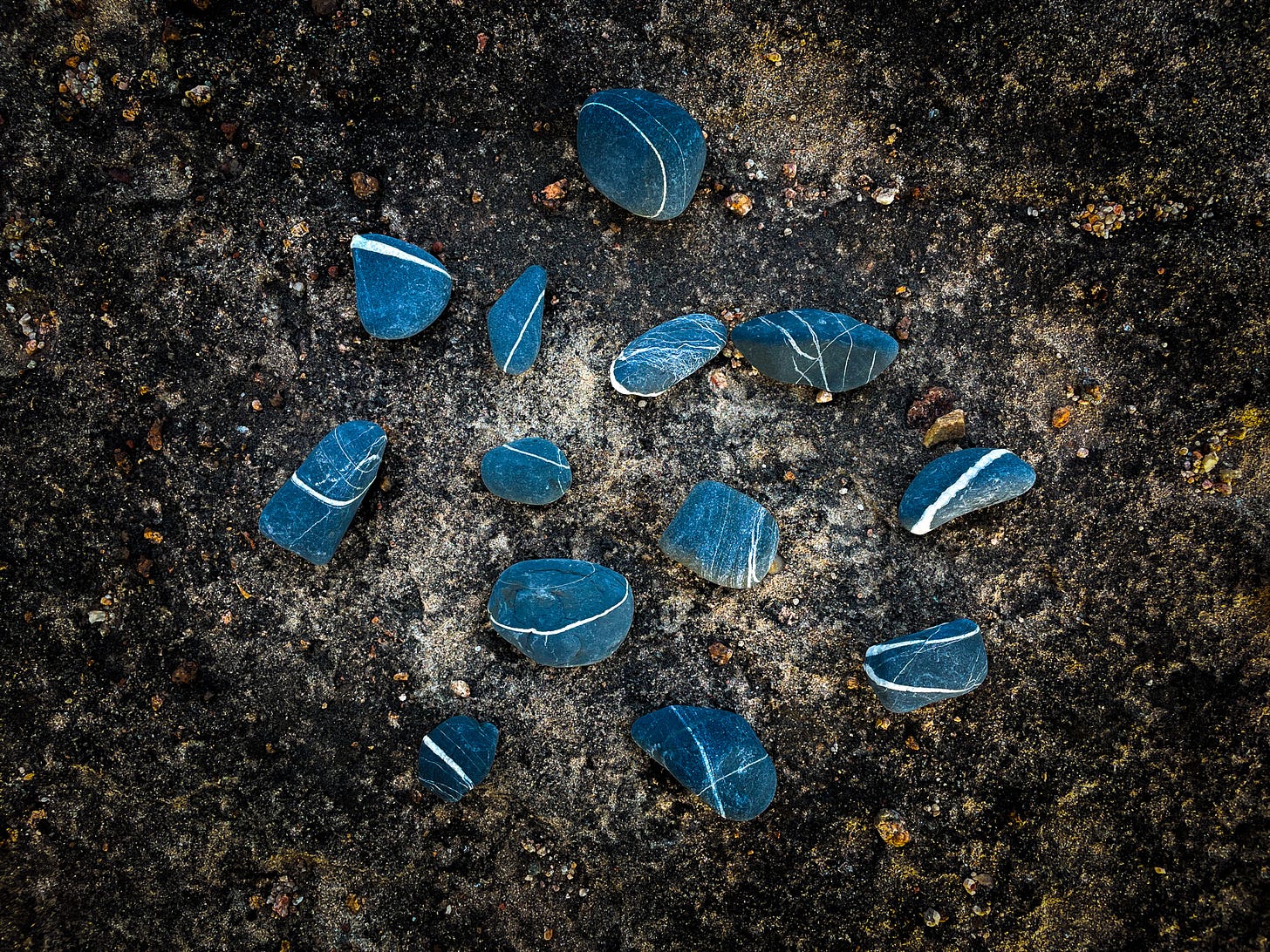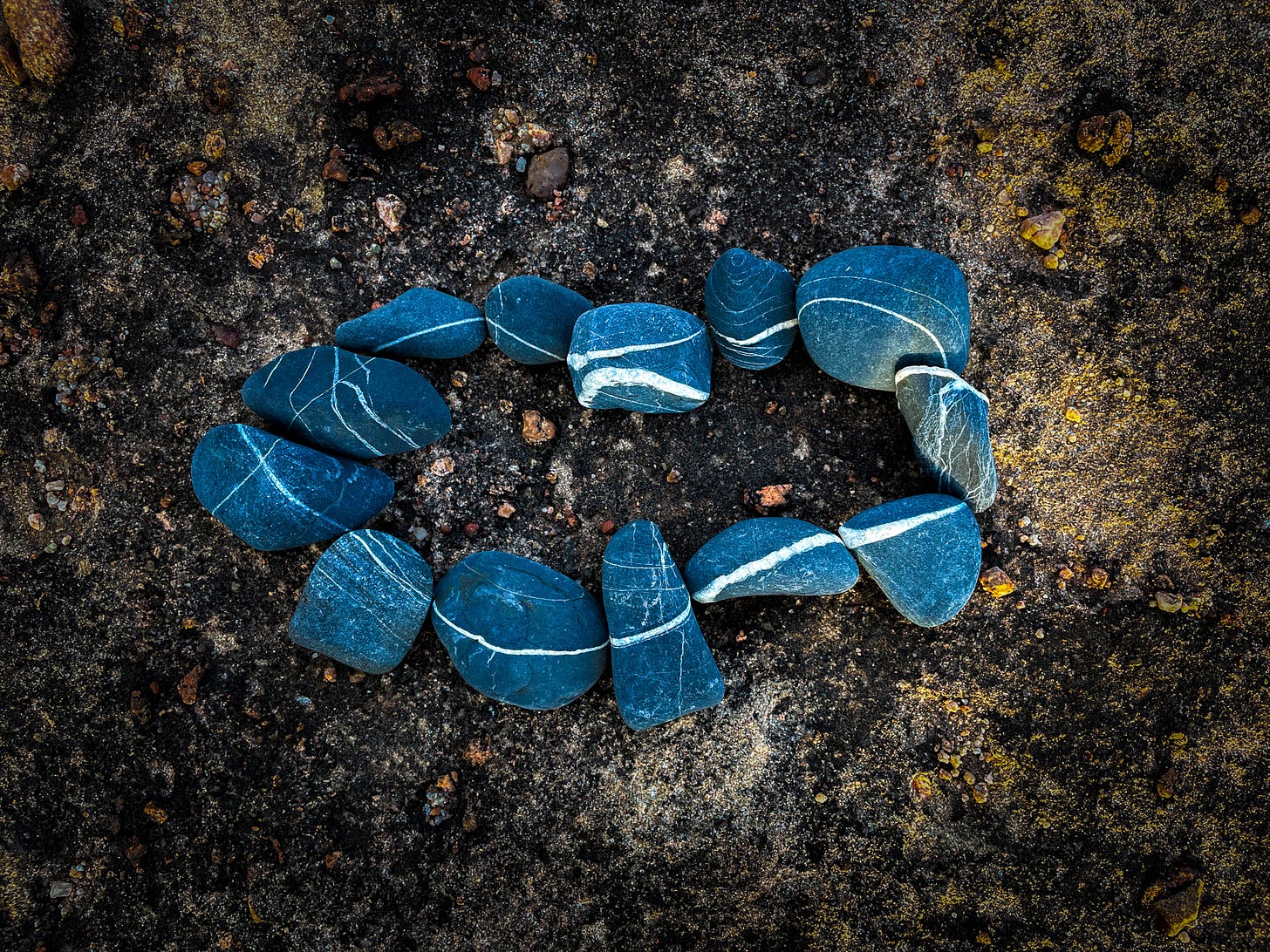Hello and welcome to this second reflection on In Fragments — this week exploring Linestone, a ritual to align the white veins in a collection of gray stones:
During a college poetry class with Yusef Komunyakaa, I remember him warning us:
“There are certain words — such as art, beauty, and love — which are difficult to be gotten into a poem.”
What he meant was that these words had become so overloaded with meanings that they no longer carried any poetical force in our culture; they lacked precision; they had become trite. That was in 2002, and now, twenty years later, I wonder how we can rediscover the original precision and power of these words — such as art, beauty, and love — whose qualities have been so foundational to every human culture over time.
The myths at the heart of our modern world tell us that we’re essentially clusters of atoms moving around a meaningless universe, competing with one another for a finite set of natural resources, so that only the fittest survive. As separate selves in such a universe, we’re encouraged to focus on our “individuality,” furnishing our personal worlds with evidence of our competitive success. This is the myth that underlies capitalism: homo economicus.
In such a world, beauty can only be the domain of the individual self: relegated to notions of attractiveness, fashion, and style. Art, traditionally the expression of beauty, then becomes yet another tradeable asset, competing in the marketplace with other works of art for money, fame, and attention. Love is then something that occurs between individuals: a transactive partnership between separate selves, who choose to form a union against the chaos of the rest of the world.
This modern condition is what Charles Eisenstein has termed “The Age of Separation,” and what Paul Kingsnorth calls “The Age of the Machine.” It is organized around an ancient impulse that lives within us all — the wish to control the unknown, to bring order to chaos, to domesticate the wild. Today, we experience this impulse through our obsession with data, surveillance, predictions, safety, security, cleanliness, convenience, and planning.
The logical endpoint of this quest for control is a totalitarian technocracy pointing people into the metaverse: a fully virtual reality where every interaction can be monitored, analyzed, optimized, controlled — and ultimately, financialized.
The price of this quest for control is a world without genuine wildness — yet wildness is the space from which all true beauty emerges, as if from a mystery.
What if we learned to see beauty, not as something to be created and possessed, but as an intrinsic property of life itself, waiting to be discovered? What if our primary role as human beings were simply to notice this beauty that already exists, and then to work to extend it by making our own environments even more beautiful — not as an economic endeavor, but as a humble act of sacred service rooted in deep respect and gratitude for the gift of being alive? In such a world, what would be the function of art?
Certain indigenous cultures actually have no word at all for the notion of “art” — to them, art is simply a way of doing things: to build artfully, to dress artfully, to speak artfully, to create artfully.
We encounter the artifacts of some of these cultures in our museums, where they are presented to us as artworks from the past — but often these objects were created in the course of everyday life: they were tools and weapons, pots and bowls, masks and costumes. They were not so much artworks as objects of life, artfully made.
One response to the perennial question “what is art” might therefore simply be: to live artfully. We might call this way of living “life as ceremony” or “life as prayer” — an orientation to life whose every gesture is an act of recognition of the latent potential that exists in each moment, and the enactment of whatever simple next steps can help to bring that potential into existence. This would be art as a kind of midwifery to potential — in other words, an act of love.
At this point, our unique human capacity for “making connections” comes into play. The basis of our tool-making ability is the way in which we compare and contrast, recognize patterns, and form combinations — we combine a stick and a stone and end up with a hammer. This connective capacity is at the root of all our technology: it is the quality of consciousness that we use to shape reality. The pertinent question is how we apply this capacity. Instead of seeking efficiency, profit, growth, and control, what kind of world would result if we chose to orient our technologies around the recognition and intensification of beauty?
In my family’s little world at High Acres Farm, millions of years of geology have conspired to produce a potent symbol for this uniquely human connective capacity — the so-called “linestones” that line the shores of Lake Champlain:
To me, these iconic stones have always seemed like puzzle pieces awaiting assembly:
When the white veins of each stone are carefully aligned with those of its neighbors, larger collective patterns begin to emerge:
This brief second ritual uses a set of these iconic local linestones to initiate the process of searching for wholeness — however crudely at first.
Wishing you bright inspiration on this dark new moon, filled with new connections…
— Jonathan








Thank you, Jonathan. I have really liked having these weekly moments of quiet ambedo with you. Hope you are well. Lisa
Hello again, Jonathan. I meant to respond immediately upon reading your post earlier in the week but was busily pursuing my own selfish interests and in the middle of something quite captivating. Your post immediately brought to mind something I read from one of my go-to thinkers, West Coast poet and Buddhist Gary Snyder. Today, I pulled up the reference in "Practice of the Wild," where Snyder tells of a Crow elder who had something important to say at a mid-seventies Native American conference in Bozeman, Mont. The elder encouraged those in attendance to set their roots in a place and listen for spiritual messages from the land, the winds and waters. He said something to the effect of "If people stay somewhere long enough -- even white people -- the spirits will begin to speak to them. It's the power of the spirits coming up from the land. The spirits and the old powers aren't lost, they just need people to be around long enough and the spirits will begin to influence them." It is apparent to me that you've already made such an intimate connection to your place on Champlain's shores. Please do continue listening and probing and sharing what you learn. This insane world can't get enough.